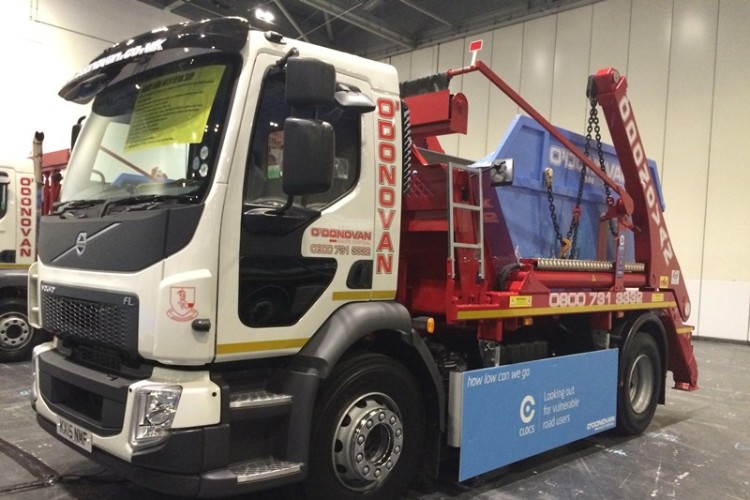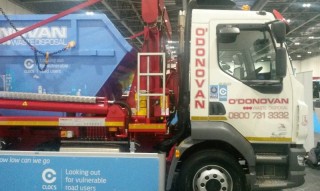Latest innovations in HGV safety were showcased yesterday at the Construction Logistics & Cycle Safety (CLOCS) progress event in London.
More than a dozen heavy goods vehicles were displayed at the CLOCS event at the ExCeL arena. Manufacturers such as Mercedes-Benz, DAF Trucks, Scania, Volvo and MAN showed new vehicles that reduce deadly blind-spots.
Between 2008 and 2013, 55% of cyclist fatalities in London involved an HGV, a disproportionate number of which were construction vehicles. Only last week a cyclist was killed under the wheels of a construction vehicle near Victoria Station.
CLOCS, which is supported and part-funded by Transport for London (TfL), was created in February 2013 following a TfL commissioned review into the causes of, and the prevention of, collisions between cyclists and the construction sector's transport. The initiative has seen progress in improving freight safety with the design of safer urban construction vehicles, reducing blind-spots and improving drivers' direct vision, giving maximum visibility of vulnerable road users. The vehicles exhibited this week will be trialled and evaluated by operators and the manufacturers in the coming months.
More than 80 organisations from across the industry are members of the programme.
One of the vehicles on show yesterday was SIG’s new delivery truck, which has a panoramic windscreen and low-level entry cab for improved view of the critical nearside front of the vehicle. It is set to be on the road by mid-2015.
For more than three years SIG has been specifying its vehicles with vulnerable road users in mind. Initial efforts were mainly focused on secondary vision aids, proximity sensors and warning signage, but it has now moved its attention to the issue of primary vision for the driver.
Replicating the mainstay of SIG’s current 1,000-strong fleet, the new vehicle is a 26-tonne rigid curtainside with a truck-mounted forklift, complete with Mercedes Benz Econic 6x2 chasis.
To further reduce blindspots, the vehicle will be also be fitted with SIG’s other standard safety features that include nearside proximity sensors, and side, rear and forward facing cameras that can display onto a monitor in the cab. The in-cab display also shows a directional view when the indicator or reverse gear is selected.

TfL head of fleet and freight Ian Wainwright said: “HGVs, in their current designs, are disproportionately represented in cyclists fatalities but thankfully SIG’s innovation is a step towards safer roads. This demonstration of the industry’s appetite for increased fleet and freight road safety shows that by supporting other manufacturers and operators to follow suit, real progress can be made on London’s roads.”
Another CLOCS supporter is O’Donovan Waste Disposal, which unveiled three new safety-optimised vehicles at the progress event. The new lorries, all of which have factory-fitted safety features specified by O’Donovan, offer improved driver vision and low-profile safety guards to provide more protection for cyclists and pedestrians.
O’Donovan's vehicles on display at the event were a Volvo FL818 skip truck and the DAF FA LF220 skip loader, both with the driving position lowered and nearside lower door glazed to increase visibility of other road users. Also featured was the MAN TGM BB skip loader, with revised suspension to lower the cab.
DAF also showed a DAF LF 16-tonne skip loader with a 3G forward-facing and multi-camera solution, developed by Intelligent Telematics. The Intelligent Telematics system includes the IT1000, described as “the most sophisticated and powerful 3G vehicle camera currently available in the marketplace”. The forward-facing camera transmits footage of accidents, near misses and harsh driving via a secure 3G private network to a web-based interface with live email and SMS alerts, so a triggered event can be viewed almost immediately.
The IT1000 forms part of a multi-camera solution that also comprises near side, off side and reverse devices, along with an in-cab monitor and digital video recorder (DVR). The in-cab monitor shows a live view to the driver from the respective camera when either the left or right indicator is flicked-on, reverse gear engaged or the vehicle speed falls below 5mph for the near side camera view to show. In addition, a side detection system using ultrasonic sensors provides warning not only for the driver to adjust their manoeuvre but also to make any adjacent cyclists or pedestrians aware of a turning vehicle.
DAF Trucks marketing manager Philip Moon said: “We are working with our customers and industry partners to showcase and raise awareness of the latest vehicle technology. By demonstrating the potential capabilities of available devices and design features, we can encourage adoption and help promote road safety amongst commercial fleet operators.”
Intelligent Telematics national account manager Daren Terry said: “Our recent research found that 3G vehicle camera technology achieved a reduction in accident frequency of 45%, while 65% of the recorded incidents were in fact avoidable. This clearly demonstrates the role technology can play in improving commercial vehicle safety levels, so we are committed to working with leading organisation such as DAF Trucks to help highlight the benefits it can achieve.”
London's transport commissioner, Sir Peter Hendy CBE, said: “Every death and injury on our roads is a tragedy and ruins lives. At TfL we are reducing these wherever possible, and are proud to be a supporter and funder of CLOCS, which has been making great progress to make all road users safer.
“The new vehicles on show today, with massively reduced blind-spots, show what can be done if people join together for a common good to solve a simple problem. We will continue our work to improve freight road safety in all aspects, be it collaboration, regulation, enforcement and lobbying, to create a capital fit for freight, and freight fit for the capital.”
Got a story? Email news@theconstructionindex.co.uk
.png)




